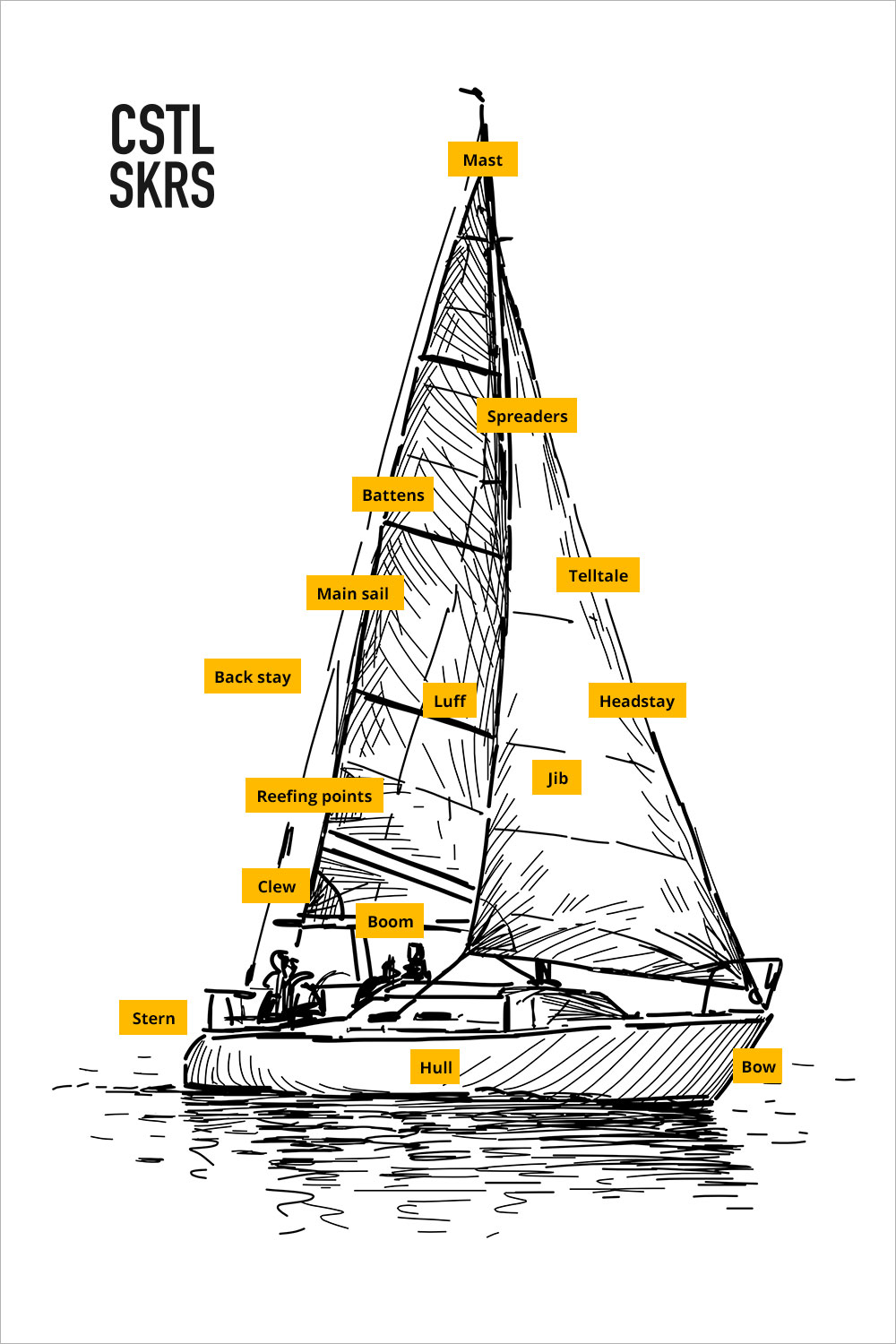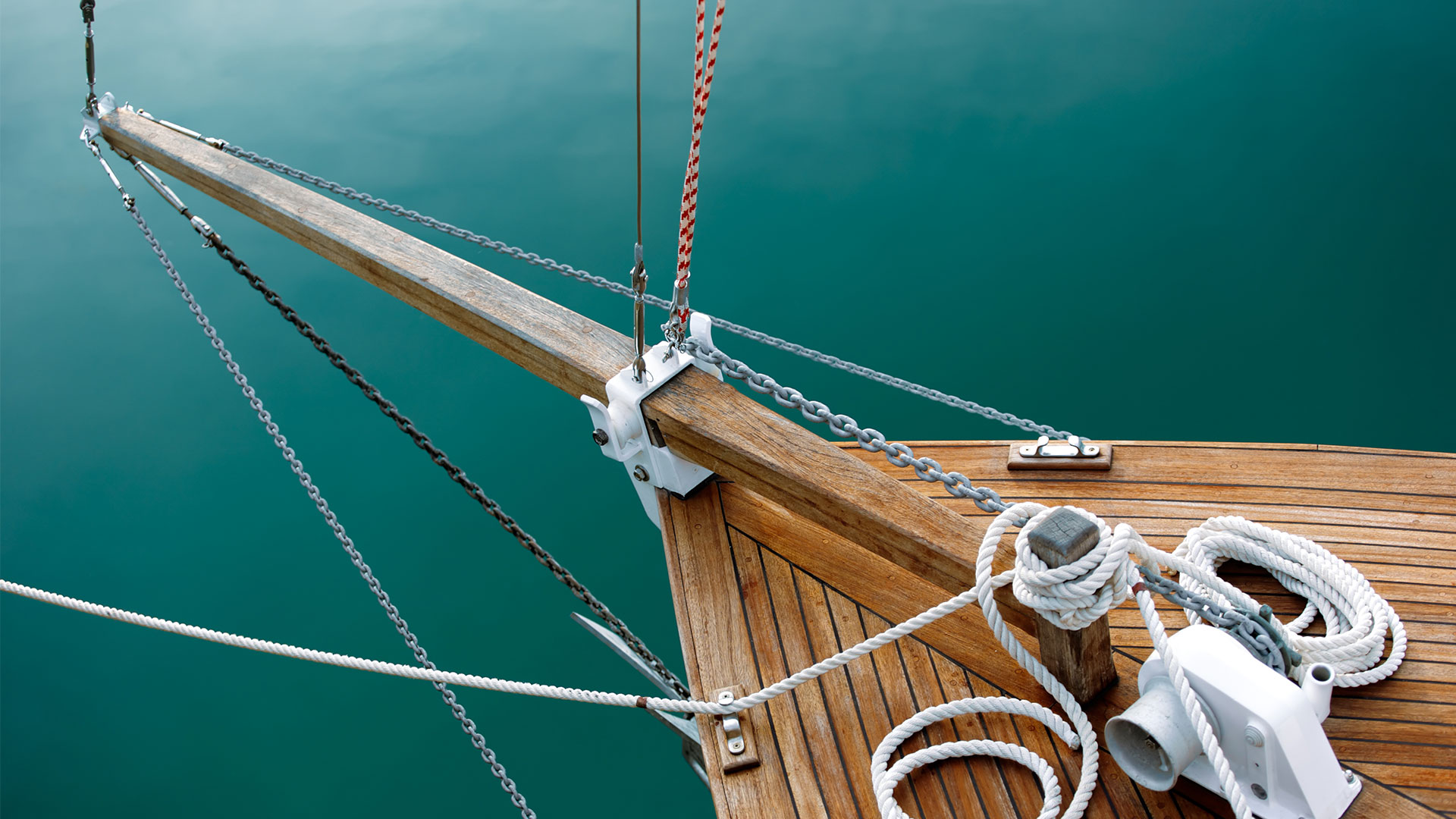The sailing basics you need to know if you want to learn to sail
A beginners guide to sailing, which outlines everything we’ve had to learn about engines, weather, rigging, self-sufficiency and terminology in order to be ready for our maiden voyage.
Jump to
So you want to become a sailor?
Whether it’s your desire for adventure, your love for the ocean, or a life without boundaries, sailing can be both exciting and scary. In this article we’ll show you everything we believe you should know up front if you’re serious about becoming a sailor.
Can you stomach it?
The seasickness aspect is an important one to consider first and although seasickness can be overcome, in most cases, over time some cannot, so having multiple sails under your belt before taking the big plunge is advised. There are tablets and patches that can help, but we’re not big fans of pills if we can help it. We prefer anti-seasickness wristbands and failing these aren’t available there’s also Ginger Gum. Sailing is extremely physical, so maintaining good health to be able to hoist the sails, which is not easy, and being generally fit enough to operate a boat is a good idea!
Say goodbye to decent sleep.
There’s multiple factors that make sleeping tough on a sailing yacht and if you’re someone who can’t operate without a perfect nights sleep you’re going to struggle at first. There’s the heat and humidity, both outside and inside the boat, splashing water, the magnified creaks and cracks in the cabin, slashing ropes, and even the occasional sea life causing a ruckus. On top of that, you have the rocking – though I have to say, I find it rather soothing.
It’s not an easy life!
Unless you’re Melnichenko, with a fully staffed super yacht. Owning your own sailing yacht will most probably mean that you will be the one responsible for the upkeep and maintenance of it. It’s a constant job and you need to be able to deal with problems as they arise, one by one, without getting frustrated. It’s costly too so you need to be prepared to ask for help and be frugal whenever you can. And with annual costs having to be accounted for, including hull outs, repaints, sail repairs, resealing, and varnishing, generally being good with your money will ensure smooth sailing – because you never know what will need replacing and where until it breaks and you don’t want to be out at sea when that happens.
These are a few of the physical and mental requirements we either had to strengthen or learn from scratch, to allow us to be confident when we finally take the plunge. But what about the actual skills required to sail? Below we’ve comprised a list of the key sailing skills we’ve had to learn and believe are a great starting place for any avid sailor.
Basic sailing physics
When we first started learning about sailing, one of the most fascinating aspects and sailing 101 begins with explaining how a sailboat moves forward. What we had imagined was completely wrong!
None of us can be blamed for this naivety, as it seems perfectly reasonable to consider a sailboat is best pushed forward from behind. And although it can be pushed from behind, it’s not the optimal and desired wind position for sailors. The way a sailboat actually works best is pure physics. It relies on two opposing forces that release energy from balancing out above and below the water. This means positioning the sails to the wind to generate thrust caused from the pressure on the sails and keel. The way we were taught was to picture a grain of rice being squeezed between two fingers, the rice has to shoot forward and this is the same for a boat. If you haven’t got a clear enough picture here’s a video to explain it better. Jump to 5.25 for a quick breakdown (these guys use a watermelon seed, each to their own).
What about capsizing?
Sailing boat designs have come along way from what they once were. Boat designers now have advanced computer models allowing them to push their designs through every possible ocean scenario. This better understanding and design makes modern sailing boats extremely hard to capsize. Weather is the usual cause of tragic capsizing with rouge and breaking waves being the prime suspects, but understanding the physics of your boat when heeled over will allow you to have better control and comfort while sailing.
Understanding the basic manoeuvres that control the way a boat moves is vital, including steering, winches, clutches, tacking and gybing, and heaving to, as well as hosting, furling and reefing. The skipper we learnt to sail with had a habit of just repeating his instructions until we eventually did the right thing – which sometimes took a bit.
Parts of a boat
Having a good understanding of the terminology used on board a sailing yacht allows you to communicate quickly a set of commands to fellow crew, other boats and shoreline authorities.
It seems like there are a bazillion terms to learn and remember when you first start. Although we don’t believe you need to know what everything is called to be an expert sailor, the professionals and die-hard enthusiasts will give you a hard time for not knowing your halyard from your jib. When we first started sailing, falling victim to this, we put the rope line around the winch the wrong way, which meant buying a round for all the crew at the pub that night! Having control of your boat is vital to sailing safely and comfortably, so knowing at least the names of the equipment used to control your boat is where we think you should start.
With a modern sailing vessel having a lot of fittings above deck, including the ropes and hardware for the spars and sails, it’s vital to understand the mechanics of how they each work together to ensure you know their purpose for when to use them. Like taking the time to learn the functions of a car, taking the time to learn the functioning parts of your sail boat will keep you safe. Plus we’ve enjoyed testing each other’s nautical term knowledge, Wikipedia has a pretty good glossary of current and dated terms.
Sailing knots
Being an avid ropes man is an essential skill to uphold as a sailor and a skill you can practise without being out on the water.
Just head to a rope shop, grab yourself a bit of line and practice. There are a number of practical and decorative knots to explore. We’ve been watching videos like the one below, over and over again until we could try to do them blindfolded – Josh is pretty proficient at a reef knot.
Rope types
There are numerous types of rope out there that will be suited for different jobs around a boat. A few things to look out for when choosing rope are its construction, material and durability. But you’ll find it’s not an exact science. Instead it’s more like an art as sailors can use various knots for different areas around a sailing vessel. Finding what works for you is not a problem, just make sure your knot does the job it’s intended for – you wouldn’t want to slip up and find your boat not where you tied it off!
Weather at sea
In tough situations being able to understand the weather is what makes you a great sailor. Although it’s different out at sea, learning what to look out for before you leave the harbour is an easy way to start learning the basics of cloud types and weather patterns.
Wind can be unpredictable at the best of times so its convenient that there’s plenty of weather information available to us today, including forecasts, charts, coastguards, fronts, navtex, weatherfax, gribfiles, and electric barometers.
There are two different weather environments that mariners prepare for. When sailing close to the shorelines the effect from the landmass will conflict with the breeze, while the headlands and bays will affect the streams and tides. When sailing offshore the prevailing weather system determines the conditions, and is actually a lot safer than the coastlines. While out at sea, staying alert of variations to the wind, tide and depth will determine major changes to the conditions.
Wind is the crux of sailing. Utilising a windex and anemometer, which are both fixed to the masthead of a sailing yacht, will help you stay on top of your direction and speed when navigating. Another way of doing this is by using the Beaufort Scale, which was created by Admiral Sir Francis Beaufort in 1805, to get an accurate measure of the wind speed by observing sea or land conditions – Beaufort promoted the creation of reliable tide tables around Britain.
Ocean map reading and navigation
You’re in the cabin, the boat is swaying, and all the while you’re trying to understand the position of the vessel on the map to yell back at the skipper the coordinates to change course to. As intimidating as the size of the ocean, learning to read ocean maps can be confronting at first.
But it’s vital to navigating the seas. Charts convey the ocean on a 2D platform and use symbols, colours and contour lines to portray all its lines and curves. They’re key to navigating potential threats, locating lights, buoys and for using these to help pinpoint positions and distance. There are plenty of digitally sophisticated gadgets out there to help you navigate, but being able to use a paper chart and sextant is still traditionally encouraged.
A sometimes-scary element to sail through can be at night. Night navigation relies on lights to identify potential obstacles. Marinas and shipping lanes use shapes and lights to distinguish the size and the type of obstruction it is. All boats and sailing vessels use flashing lights in repeating patterns to indicate the size and type of vessel it is.
The sky is such a mystical place. We often hear that we know more about the surface of the Moon or Mars than the open ocean, so it’s amazing that we can use the positions of the sun, moon and stars against the measurement of the horizon to locate your position on the globe. This will be a project we explore while sailing.
Sailing vessel engines
A sailboats engine is used for a few different reasons.
When the wind fails, which it sometimes will, to prevent yourself from being stuck out at sea like a bobbing duck helpless to the elements it’s important to have an engine on your sailing boat.
Most sail vessels use diesel engines as they are known to be reliable and safe but with rising fuel costs they’re a great deal more expensive. Learning about your sailing vessel’s many systems and how they should be maintained is a part of a boat owner’s responsibilities. We’ve been encouraged as even occasional sailors to become familiar with essential boat maintenance skills.
Throughout the year, there are a number of things that you have to keep on top of including engine services, steering maintenance, rig checks and repairs, sail maintenance, and hull maintenance. Thankfully, though, marine engines aren’t what they used to be and are much simpler to maintaine than the below video.
Do you have what it takes?
If you aren’t completely put off the idea of a sailors life from reading the above then why not give it a go! There are plenty of sailing holidays, courses and schools, and if you get hooked like us then it could be the start of a big adventure.










